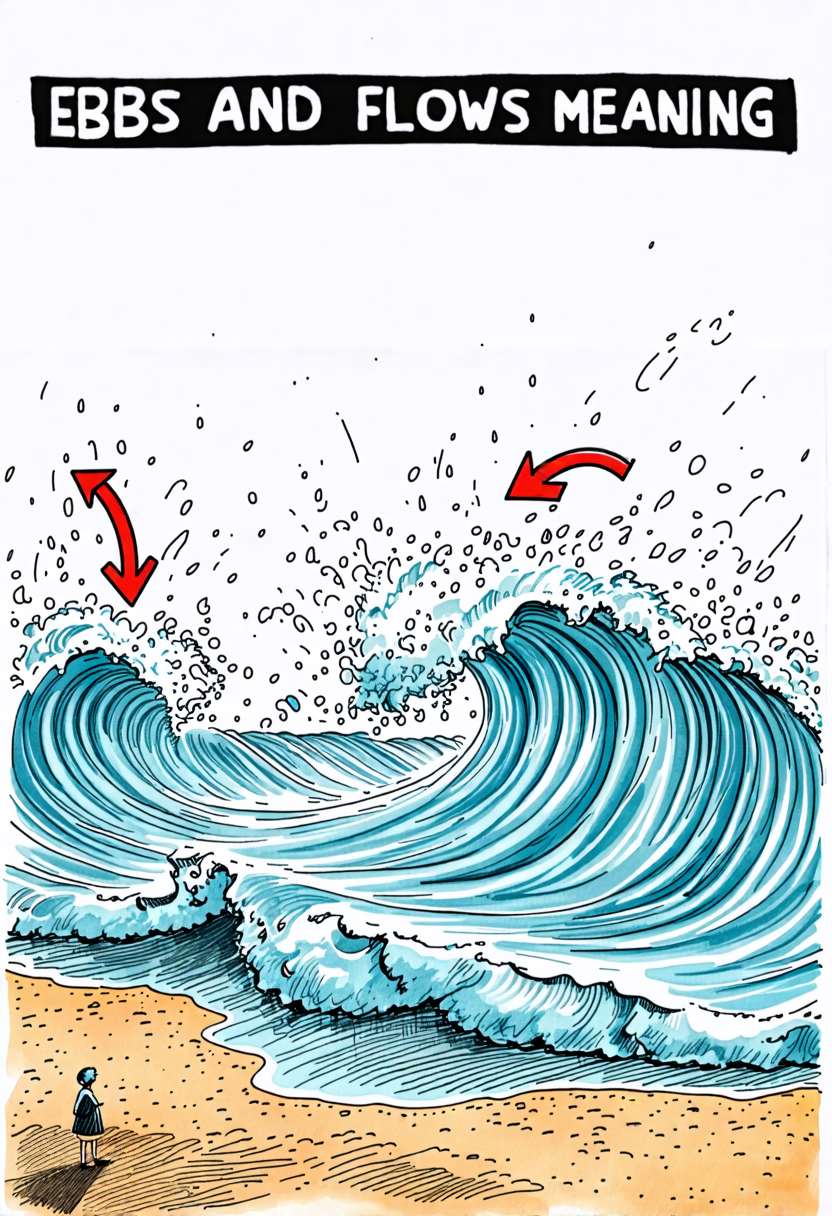Ebbs and Flows Meaning
The phrase “ebbs and flows” reflects the natural rhythm of life, involving continuous cycles of rises and declines. It highlights the inevitability of change, showing how growth and reduction are inherent in various aspects of our lives, from emotions and markets to relationships and seasons.
Definition of ‘Ebbs and Flows’
The phrase ‘ebbs and flows’ refers to the natural rhythm of life marked by continuous changes and fluctuations. It signifies the constant shift between rises and declines. This idiom captures the essence of life’s inevitable ups and downs.
Synonyms for ‘ebbs and flows’ include fluctuations and variances. Often, the expression is used to describe the highs and lows in various aspects of life such as emotions, fortunes, and circumstances. It underscores the non-static nature of existence, emphasizing that change is a constant.
Natural Life Rhythm
Understanding the natural life rhythm involves recognizing the continuous ebb and flow of experiences. Life is inherently cyclical, marked by periods of growth and decline. This rhythmic pattern is evident in various aspects of existence, from the changing seasons to the ups and downs of personal and professional life.

These fluctuations are natural and inevitable, guiding us through moments of prosperity and challenge. By embracing this rhythm, we can better navigate life’s unpredictability. It teaches us to appreciate the highs and remain resilient during the lows.
Continuous Change
Life’s natural rhythm highlights the inevitability of continuous change. This concept is at the heart of the idiom ‘ebbs and flows.’ Continuous change means that nothing remains static. Everything is in a state of flux, moving between different phases.
In personal life, it could mean shifting emotions or changing circumstances. In the economy, it manifests as market fluctuations. Nature itself exemplifies this through changing seasons and weather patterns.
Recognizing continuous change allows individuals and organizations to adapt effectively. It emphasizes the need for flexibility and resilience. Understanding that change is constant helps in managing expectations and preparing for the future.
Rise and Decline
Often, ‘ebbs and flows’ describe the inevitable rise and decline seen in various aspects of life. This idiom captures the cyclical nature of many phenomena.
In business, companies experience periods of growth and contraction. Economies expand during booms and contract during recessions.
Personal relationships also undergo phases of closeness and distance. Nature itself demonstrates this pattern, with seasons changing from growth in spring to dormancy in winter.
Recognizing these patterns helps in anticipating changes and preparing for future challenges. Understanding the rise and decline inherent in ‘ebbs and flows’ allows individuals and organizations to navigate life’s uncertainties more effectively, adapting strategies to manage both prosperous and challenging times.
Synonyms and Similar Idioms
Synonyms for ‘ebbs and flows’ include fluctuations, highs and lows, and ups and downs. Each term captures the essence of continuous change and the natural rhythm of life.
For instance, fluctuations refer to the rise and fall in variables such as stock prices. Highs and lows describe the varying periods of success and challenges one might face. Ups and downs convey the inevitable shifts in emotions, relationships, or circumstances.
Similar idioms include ‘wax and wane,’ which is often used to describe the moon’s phases, and ‘peaks and valleys,’ highlighting periods of significant growth followed by declines. These expressions help illustrate the inherent variability in different aspects of life.
Tide Movements Origin
Similar to how synonyms for ‘ebbs and flows’ mirror life’s variability, the origin of this idiom is rooted in the natural tide movements. The phrase captures the essence of the cyclical nature of tides, where ‘ebb’ represents the receding tide and ‘flow’ signifies its return.
This natural phenomenon illustrates the constant rise and decline, making it a fitting metaphor for life’s fluctuations. The idiom first appeared in the 16th century, reflecting society’s close connection with the sea. Over time, it was adopted more broadly to describe any rhythmic change.
Versatile Expression
The phrase ‘ebbs and flows’ serves as a versatile expression to describe the natural fluctuations and changes in various contexts. It captures the essence of life’s inherent variability.
This idiom is particularly useful for illustrating the dynamic nature of different aspects of life. Whether applied to the economy, relationships, or personal experiences, ‘ebbs and flows’ effectively highlights periods of growth and decline.
Its simplicity and clarity make it a powerful tool for communication. By acknowledging these natural rhythms, individuals can better prepare for and adapt to changes.
Various Contexts
‘Ebbs and flows’ can be applied to diverse contexts, capturing the inherent variability in everything from financial markets to personal relationships.
In the world of finance, this phrase describes the inevitable rise and fall of stock prices, reflecting market volatility.
In personal relationships, it highlights periods of closeness and distance, illustrating the dynamic nature of human connections.
The term is also relevant in business, where companies experience phases of growth and decline.
Similarly, in creative endeavors, ‘ebbs and flows’ signify alternating periods of inspiration and creative blocks.
Practical Examples
Understanding ‘ebbs and flows’ through practical examples helps illustrate its relevance in everyday life. The stock market is a prime example, known for its frequent fluctuations. Investors must navigate these ups and downs to make informed decisions.
Relationships also experience ebbs and flows, with periods of closeness and distance. This natural rhythm helps couples grow and adapt.
In nature, the literal ebb and flow of tides exemplify this concept, as waves continuously crash and recede.
Musicians often face career ebbs and flows, alternating between fame and obscurity.
Lastly, the creative process itself is subject to ebbs and flows, with moments of inspiration followed by creative blocks.







